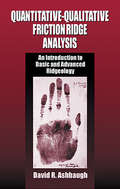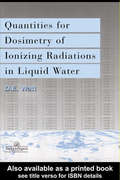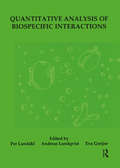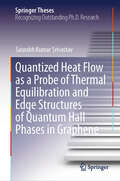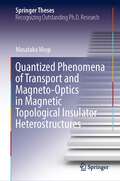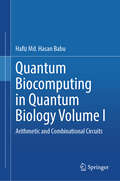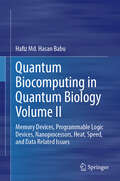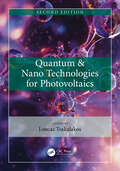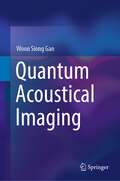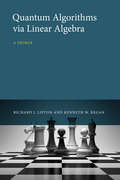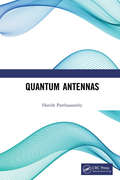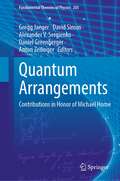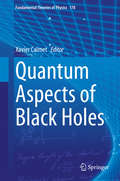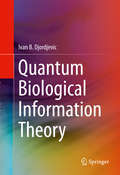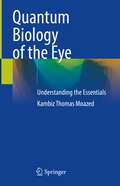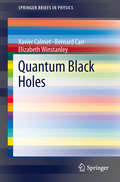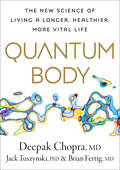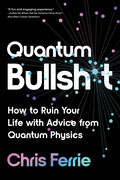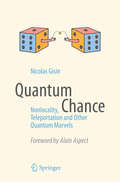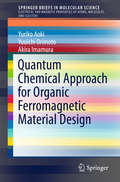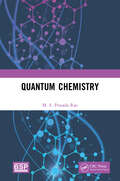- Table View
- List View
Quantitative-Qualitative Friction Ridge Analysis: An Introduction to Basic and Advanced Ridgeology (ISSN)
by David R. AshbaughThe science of fingerprint identification isn‘t always cut and dry. This book examines the latest methods and techniques in the science of friction ridge identification, or ridgeology. The author examines every facet of the discipline, from the history of friction ridge identification to the scientific basis and the various steps of the identification process. The book, which features several detailed illustrations and photographs, also includes a new method for Palmar Flexion Crease Identification (palm lines) designed by the author and which has helped solve several criminal cases where fingerprints were not available.
Quantities For Generalized Dosimetry Of Ionizing Radiations in Liquid Water
by D E WattIntended as a reference handbook of quantities used in dosimetry of ionizing radiations. Fields of application are radiological protection, environmental radiation, health physics, nuclear medicine and radiotherapy, radiobiology, radiopharmacy and radiation chemistry. The book is in three parts. The first part deals with electrons, X-rays and gamma
Quantitive Analysis Of Biospec
by Per Lundahl; Andreas Lundqvist; Eva GreijerFirst published in 2004, this book collects several up-to-date methods for quantitative analysis of biospecific interactions, a field that has a long history that perhaps can be said to have begun with the classical paper of G. Scatchard in 1949 (The attractions of proteins for small molecules and ions, but which has advanced impressively during the last few years. A precise spatial arrangement of just a few hydrogen bonds can confer a remarkably specific reversible association between two molecules. A web of weak interactions governs biospecific recognition in general. The binding equilibria in living cells tune and coordinate a multitude of functions. The thermodynamic properties of such interactions are often studied by binding experiments in simplified and essentially ideal systems. However, similar types of studies may elucidate the biologically relevant dynamic steady-state conditions in living cells and organisms, allowing for the very wide range of interactant concentrations and the interplay between the many reactions and interactions. The development in biosciences will continue with in-depth studies of macromolecules and membranes. More detailed knowledge will allow analyses of delicate balances between substances and events in the complex systems involved in life processes. Methods to study biospecific affinities are thus highly important tools for understanding mechanisms and effects of molecular binding events in vivo and in vitro, e.g., in biochemical, biomedical and pharmaceutical research, and for biotechnological research and production.
Quantized Heat Flow as a Probe of Thermal Equilibration and Edge Structures of Quantum Hall Phases in Graphene (Springer Theses)
by Saurabh Kumar SrivastavThis book describes the quantized thermal conductance measurements of integer and several fractional quantum Hall (QH) states realized in graphene devices. Although the electrical conductance quantization of the QH effect in graphene was demonstrated in 2005, a heat flow study of QH states needed to be included. This becomes particularly essential for the hole-conjugate fractional QH phases, where counterpropagating edge modes lead to complex transport behavior. The experimental results reported in this thesis are the first set of experiments done for the quantized heat flow in graphene devices since the first mechanical isolation of graphene flakes. The book devotes two detailed introductory chapters to the electronic properties of the graphene and its bilayer and trilayer parts at zero magnetic fields, and to the essential physics of the integer and fractional quantum Hall (FQH) states, the topological order of FQH phases and the experiments that can detect them. The book has a dedicated chapter for the details of the device fabrication and thermal conductance measurement technique. The rest of the chapters are dedicated to the systematic and detailed documentation of the new experimental findings of quantized heat flow in quantum Hall phases in graphene.
Quantized Phenomena of Transport and Magneto-Optics in Magnetic Topological Insulator Heterostructures (Springer Theses)
by Masataka MogiThis book presents experimental studies on emergent transport and magneto-optical properties in three-dimensional topological insulators with two-dimensional Dirac fermions on their surfaces. Designing magnetic heterostructures utilizing a cutting-edge growth technique (molecular beam epitaxy) stabilizes and manifests new quantization phenomena, as confirmed by low-temperature electrical transport and time-domain terahertz magneto-optical measurements. Starting with a review of the theoretical background and recent experimental advances in topological insulators in terms of a novel magneto-electric coupling, the author subsequently explores their magnetic quantum properties and reveals topological phase transitions between quantum anomalous Hall insulator and trivial insulator phases; a new topological phase (the axion insulator); and a half-integer quantum Hall state associated with the quantum parity anomaly. Furthermore, the author shows how these quantum phases can be significantly stabilized via magnetic modulation doping and proximity coupling with a normal ferromagnetic insulator. These findings provide a basis for future technologies such as ultra-low energy consumption electronic devices and fault-tolerant topological quantum computers.
Quantum Biocomputing in Quantum Biology Volume I: Arithmetic and Combinational Circuits
by Hafiz Md. Hasan BabuThe book starts with the basics of Quantum Computing, Biocomputing, Quantum Biology, Quantum-DNA Computing, and DNA-Quantum Computing. It also discusses the fundamental operations in quantum computing and Biocomputing. Different types of quantum arithmetic circuits, quantum-DNA arithmetic circuits and DNA-quantum arithmetic circuits such as basic and universal gate operations, half-adder, full-adder, half subtractor, full subtractor, N-qubit adders, multipliers, dividers, etc., are explained clearly. Nuclear Magnetic Resonance (NMR), NMR relaxation, quantum cache memory, heat conduction circuit, and trap ion are also discussed. The readers can get a clear idea about different types of quantum, quantum-DNA and DNA-quantum circuits such as arithmetic, combinational, sequential, memory devices, programmable logic devices, nano-processors and will be able to design their own circuits. Then, it discusses Heat Measurement, Speed Calculation, Heat Transfer, Data Conversion, and Data Management in Quantum Computing and Quantum Biocomputing (Quantum-DNA Computing and DNA-Quantum Computing). As a whole, this book is a great resource for quantum, quantum-DNA and DNA-Quantum Computing, it is the book where computing in quantum biology is introduced for the quantum biology researchers, students, and academicians. This is a novel approach to writing a book in this field. This book quenches the thirst of beginners to advanced-level readers.
Quantum Biocomputing in Quantum Biology Volume II: Memory Devices, Programmable Logic Devices, Nanoprocessors, Heat, Speed, and Data Related Issues
by Hafiz Md. Hasan BabuThe book starts with the basics of Quantum Computing, Biocomputing, Quantum Biology, Quantum-DNA Computing, and DNA-Quantum Computing. It also discusses the fundamental operations in quantum computing and Biocomputing. Different types of quantum arithmetic circuits, quantum-DNA arithmetic circuits and DNA-quantum arithmetic circuits such as basic and universal gate operations, half-adder, full-adder, half subtractor, full subtractor, N-qubit adders, multipliers, dividers, etc., are explained clearly. Nuclear Magnetic Resonance (NMR), NMR relaxation, quantum cache memory, heat conduction circuit, and trap ion are also discussed. The readers can get a clear idea about different types of quantum, quantum-DNA and DNA-quantum circuits such as arithmetic, combinational, sequential, memory devices, programmable logic devices, nano-processors and will be able to design their own circuits. Then, it discusses Heat Measurement, Speed Calculation, Heat Transfer, Data Conversion, and Data Management in Quantum Computing and Quantum Biocomputing (Quantum-DNA Computing and DNA-Quantum Computing). As a whole, this book is a great resource for quantum, quantum-DNA and DNA-Quantum Computing, it is the book where computing in quantum biology is introduced for the quantum biology researchers, students, and academicians. This is a novel approach to writing a book in this field. This book quenches the thirst of beginners to advanced-level readers.
Quantum & Nano Technologies for Photovoltaics
by Loucas TsakalakosOngoing concerns regarding greenhouse gas-related environmental effects, energy security, and the rising costs of conventional energy sources has led to sustained interest and growth in solar energy in general, and photovoltaics in particular. Exploring state-of-the-art developments from a practical point of view, Quantum and Nanotechnology for Photovoltaics is the second edition of the book and examines issues in increasing efficiency, decreasing costs, and how these two goals can be achieved in a single photovoltaic device leveraging emergent quantum and nanoscale phenomena.The book provides fundamental background, including new chapters on quantum physics, hot carrier solar cells, luminescent solar concentrators, and additional topics, and places research approaches within the proper physical context as related to photovoltaics performance enhancement. It reviews the applications of devices and their performance requirements, followed by coverage of thin films and advanced band structure concepts for obtaining efficiencies above the Shockley–Queisser single band-gap efficiency limit of 31%. The editor and contributors also discuss the basic optical properties of nanostructured materials as related to photovoltaics applications and describes quantum hot-carrier device physics related to performance. They then explore recent literature in the application of various classes of nanostructures to photovoltaics. The book covers solar cells based on hybrid organic-inorganic nanocomposites structures, quantum wells, nanowires/tubes, and quantum dots. It also discusses the use of nanoparticles/quantum dots to enhance the performance of conventional solar cells and quantum-enhanced luminescent solar concentrators.Each chapter summarizes the historical development for the nanostructure class under consideration, applications beyond photovoltaics, and the major synthetic methods, followed by a critique of leading works that have employed the particular quantum and/or nanostructure type. The book examines the advantages of each quantum/nanostructure approach and the remaining technical challenges, with an emphasis on possible future areas of research interest. This work is intended for academic and industrial researchers developing new photovoltaic technologies, primarily at the graduate level and beyond, though senior-level undergraduates with appropriate training in physics and materials science will also benefit from this book. Many of the chapters also constitute useful background knowledge for managers and decision-makers in companies developing advanced photovaltaic, energy, and materials technologies.
Quantum Acoustical Imaging
by Woon Siong GanThis book highlights the theories and applications of quantum acoustical imaging which can be considered as a part of quantum technology. It starts with the theories and background principles of this new field in depth.The examples of some present forms of available acoustical imaging which can be considered as quantum acoustical imaging are given such as ultrasonics in the terahertz range with the use of optical transducers for producing terahertz ultrasound and the theory of sound amplification by stimulated emission of radiation (SASER) and principles based on terahertz ultrasound. The SASER transducer is described, followed by the applications of SASER.Other examples of quantum acoustical imaging are the atomic force acoustic microscope (AFAM) and the ultrasonic force microscope. The author’s personal inventions of quantum acoustical imaging are a system based on phonons entanglement based on the quantum property of phonons entanglement and the quantum ultrasound diffraction tomography system.The advantage of quantum acoustical imaging is the defeat of the classical Rayleigh image resolution limit. An unique feature of this book is that it has gone in depth into the quantum theories of acoustical imaging such as phonons entanglement,,superposition principle and the application of transport theory.Quantum microphones and quantum transducers are also introduced with a final chapter on quantum image processing.
Quantum Adaptivity in Biology: From Genetics to Cognition
by Andrei Khrennikov Masanari Asano Masanori Ohya Yoshiharu Tanaka Ichiro YamatoThis book examines information processing performed by bio-systems at all scales: from genomes, cells and proteins to cognitive and even social systems. It introduces a theoretical/conceptual principle based on quantum information and non-Kolmogorov probability theory to explain information processing phenomena in biology as a whole. The book begins with an introduction followed by two chapters devoted to fundamentals, one covering classical and quantum probability, which also contains a brief introduction to quantum formalism, and another on an information approach to molecular biology, genetics and epigenetics. It then goes on to examine adaptive dynamics, including applications to biology, and non-Kolmogorov probability theory. Next, the book discusses the possibility to apply the quantum formalism to model biological evolution, especially at the cellular level: genetic and epigenetic evolutions. It also presents a model of the epigenetic cellular evolution based on the mathematical formalism of open quantum systems. The last two chapters of the book explore foundational problems of quantum mechanics and demonstrate the power of usage of positive operator valued measures (POVMs) in biological science. This book will appeal to a diverse group of readers including experts in biology, cognitive science, decision making, sociology, psychology, and physics; mathematicians working on problems of quantum probability and information and researchers in quantum foundations.
Quantum Algorithms via Linear Algebra: A Primer
by Richard J. Lipton Kenneth W. ReganQuantum computing explained in terms of elementary linear algebra, emphasizing computation and algorithms and requiring no background in physics.This introduction to quantum algorithms is concise but comprehensive, covering many key algorithms. It is mathematically rigorous but requires minimal background and assumes no knowledge of quantum theory or quantum mechanics. The book explains quantum computation in terms of elementary linear algebra; it assumes the reader will have some familiarity with vectors, matrices, and their basic properties, but offers a review of all the relevant material from linear algebra. By emphasizing computation and algorithms rather than physics, this primer makes quantum algorithms accessible to students and researchers in computer science without the complications of quantum mechanical notation, physical concepts, and philosophical issues.After explaining the development of quantum operations and computations based on linear algebra, the book presents the major quantum algorithms, from seminal algorithms by Deutsch, Jozsa, and Simon through Shor's and Grover's algorithms to recent quantum walks. It covers quantum gates, computational complexity, and some graph theory. Mathematical proofs are generally short and straightforward; quantum circuits and gates are used to illuminate linear algebra; and the discussion of complexity is anchored in computational problems rather than machine models. Quantum Algorithms via Linear Algebra is suitable for classroom use or as a reference for computer scientists and mathematicians.
Quantum Antennas
by Harish ParthasarathyThis book is about several questions regarding how to describe the quantization of the current density in an antenna and about the nature of the quantum electromagnetic field produced by such a quantum current density. The second quantized current density can be built out of the Dirac field of electrons and positrons while the free electromagnetic or photon field is built out of solutions to the wave equation with coefficients being operators, namely the creation and annihilation operators of the photons. Note: T&F does not sell or distribute the Hardback in India, Pakistan, Nepal, Bhutan, Bangladesh and Sri Lanka.
Quantum Arrangements: Contributions in Honor of Michael Horne (Fundamental Theories of Physics #203)
by David Simon Gregg Jaeger Anton Zeilinger Alexander V. Sergienko Daniel GreenbergerThis book presents a collection of novel contributions and reviews by renowned researchers in the foundations of quantum physics, quantum optics, and neutron physics. It is published in honor of Michael Horne, whose exceptionally clear and groundbreaking work in the foundations of quantum mechanics and interferometry, both of photons and of neutrons, has provided penetrating insight into the implications of modern physics for our understanding of the physical world. He is perhaps best known for the Clauser-Horne-Shimony-Holt (CHSH) inequality. This collection includes an oral history of Michael Horne's contributions to the foundations of physics and his connections to other eminent figures in the history of the subject, among them Clifford Shull and Abner Shimony.
Quantum Aspects of Black Holes
by Xavier CalmetBeginning with an overview of the theory of black holes by the editor, this book presents a collection of ten chapters by leading physicists dealing with the variety of quantum mechanical and quantum gravitational effects pertinent to black holes. The contributions address topics such as Hawking radiation, the thermodynamics of black holes, the information paradox and firewalls, Monsters, primordial black holes, self-gravitating Bose-Einstein condensates, the formation of small black holes in high energetic collisions of particles, minimal length effects in black holes and small black holes at the Large Hadron Collider. Viewed as a whole the collection provides stimulating reading for researchers and graduate students seeking a summary of the quantum features of black holes.
Quantum Aspects of Black Holes (Fundamental Theories of Physics #178)
by Xavier CalmetBeginning with an overview of the theory of black holes by the editor, this book presents a collection of ten chapters by leading physicists dealing with the variety of quantum mechanical and quantum gravitational effects pertinent to black holes. The contributions address topics such as Hawking radiation, the thermodynamics of black holes, the information paradox and firewalls, Monsters, primordial black holes, self-gravitating Bose-Einstein condensates, the formation of small black holes in high energetic collisions of particles, minimal length effects in black holes and small black holes at the Large Hadron Collider. Viewed as a whole the collection provides stimulating reading for researchers and graduate students seeking a summary of the quantum features of black holes.
Quantum Atom Optics: Theory and Applications to Quantum Technology
by Tim Byrnes Ebubechukwu O. Ilo-OkekeThe rapid development of quantum technologies has driven a revolution in related research areas such as quantum computation and communication, and quantum materials. The first prototypes of functional quantum devices are beginning to appear, frequently created using ensembles of atoms, which allow the observation of sensitive, quantum effects, and have important applications in quantum simulation and matter wave interferometry. This modern text offers a self-contained introduction to the fundamentals of quantum atom optics and atomic many-body matter wave systems. Assuming a familiarity with undergraduate quantum mechanics, this book will be accessible for graduate students and early career researchers moving into this important new field. A detailed description of the underlying theory of quantum atom optics is given, before development of the key, quantum, technological applications, such as atom interferometry, quantum simulation, quantum metrology, and quantum computing.
Quantum Biological Information Theory
by Ivan B. DjordjevicThis book is a self-contained, tutorial-based introduction to quantum information theory and quantum biology. It serves as a single-source reference to the topic for researchers in bioengineering, communications engineering, electrical engineering, applied mathematics, biology, computer science, and physics. The book provides all the essential principles of the quantum biological information theory required to describe the quantum information transfer from DNA to proteins, the sources of genetic noise and genetic errors as well as their effects. Integrates quantum information and quantum biology concepts; Assumes only knowledge of basic concepts of vector algebra at undergraduate level; Provides a thorough introduction to basic concepts of quantum information processing, quantum information theory, and quantum biology; Includes in-depth discussion of the quantum biological channel modelling, quantum biological channel capacity calculation, quantum models of aging, quantum models of evolution, quantum models on tumor and cancer development, quantum modeling of bird navigation compass, quantum aspects of photosynthesis, quantum biological error correction.
Quantum Biology of the Eye: Understanding the Essentials
by Kambiz Thomas MoazedAs we enter the quantum era, new research on applying the rules of quantum physics to biology, which was previously considered impossible, has revolutionized our understanding and our concept of molecular and atomic particles behavior and their interactions. This book is the first comprehensive review of the quantum biology of the visual system. Chapters discuss the relevance of quantum physics to the biological systems, especially in the visual system. The main purpose of this book is to simplify quantum biology concepts relevant to physiology of human eye and to help the reader understand the essentials of this new emerging, complex and anti-intuitive field of science. It offers a contemporary view of the emerging interplay between the biochemistry, physiology, molecular biology, and molecular and atomic particle quantum characteristics such as vibration, spin etc.Quantum Biology of the Eye is an essential resource for Ophthalmologists, physicians, residents, fellows, all fields of visual science and medical students in ophthalmology, and other converging fields of science such as visual optics biochemists, psychology etc.
Quantum Black Holes
by Xavier Calmet Bernard Carr Elizabeth WinstanleyWritten by foremost experts, this short book gives a clear description of the physics of quantum black holes. The reader will learn about quantum black holes in four and higher dimensions, primordial black holes, the production of black holes in high energy particle collisions, Hawking radiation, black holes in models of low scale quantum gravity and quantum gravitational aspects of black holes.
Quantum Body: The New Science of Living a Longer, Healthier, More Vital Life
by Deepak Chopra Brian Fertig Jack TuszynskJoining forces with two leading scientists, New York Times bestselling author Deepak Chopra offers a quantum leap for improving our physical and mental health. In an unprecedented collaboration between three of today&’s most powerful minds, Deepak Chopra, M.D., teams up with physicist Jack Tuszynski, Ph.D., and endocrinologist Brian Fertig, M.D., to bring readers a visionary work that delves into the innovative world of quantum science and shows how unlocking its secrets can revolutionize how we live and age—and, ultimately, how we can eradicate disease. The key is the quantum body. Unlike our physical body, which is subject to aging, injury, and decay, the quantum body exists on a sub-atomic level and is the infinite, invisible source of everyday reality that affects your thoughts, feelings, sensations, and biological responses. Without your quantum body, there is no physical body. And this lack of awareness of the most crucial part of ourselves negatively impacts our lives every day. Through a powerful combination of prescriptive exercises and innovative research into the quantum world, the authors unveil seven breakthroughs that will revolutionize the future of everyone&’s well-being. Central to this revolution is a groundbreaking understanding of metabolism—the way our cells process energy—that promises to challenge our understanding of modern medicine as we know it.Though all too familiar in the physical world, Alzheimer&’s, type 2 diabetes, cancer, and heart disease do not exist at the fundamental level of quantum reality. By harnessing the power of the quantum body, we can significantly improve our physical and mental well-being, including supporting healthy cell, tissue, and organ function, boosting immunity, promoting mental resilience, and expanding our understanding of what it means to live a happy and purposeful life.In this groundbreaking book, Chopra, Tuszynski, and Fertig show you the way by unveiling the &“real&” reality of your body and mind as never before and providing a vision for a tomorrow that is already here.
Quantum Bullsh*t: How to Ruin Your Life with Advice from Quantum Physics
by Chris FerrieScience is so f*cking rad. We don't deserve it.What actually is quantum physics? If you can answer that questions without bullsh*tting the person standing next to you in the bookstore, you can stop reading right now. But although most of us don't actually understand quantum physics, we know that it's mystical and awesome, and if we understood it we'd probably be rich and beautiful and happy, right? After all, there are plenty of people out there trying to sell you quantum crystals to align your quantum energy with your quantum destiny. Can they all be wrong?Spoiler: yes. Yes, they can. There is no such thing as quantum crystals. Sorry!Luckily, as pseudo-science takes over the internet and it's getting harder and harder to separate alternative facts from real science, Chris Ferrie (an actual quantum physicist!) is here to explain quantum physics in a way that makes sense, so you can see the hucksters and bullsh*tters coming from a mile away—and school them in what quantum entanglement actually is (it has nothing to do with your romantic life). If you f*cking love science and want to be slightly less dumb than you were when you woke up this morning, Quantum Bullsh*t is the truly out-of-this-world book for you.
Quantum Chance
by Nicolas GisinQuantum physics, which offers an explanation of the world on the smallest scale, has fundamental implications that pose a serious challenge to ordinary logic. Particularly counterintuitive is the notion of entanglement, which has been explored for the past 30 years and posits an ubiquitous randomness capable of manifesting itself simultaneously in more than one place. This amazing 'non-locality' is more than just an abstract curiosity or paradox: it has entirely down-to-earth applications in cryptography, serving for example to protect financial information; it also has enabled the demonstration of 'quantum teleportation', whose infinite possibilities even science-fiction writers can scarcely imagine. This delightful and concise exposition does not avoid the deep logical difficulties of quantum physics, but gives the reader the insights needed to appreciate them. From 'Bell's Theorem' to experiments in quantum entanglement, the reader will gain a solid understanding of one of the most fascinating areas of contemporary physics.
Quantum Chance: Nonlocality, Teleportation and Other Quantum Marvels
by Nicolas GisinQuantum physics, which offers an explanation of the world on the smallest scale, has fundamental implications that pose a serious challenge to ordinary logic. Particularly counterintuitive is the notion of entanglement, which has been explored for the past 30 years and posits an ubiquitous randomness capable of manifesting itself simultaneously in more than one place.This amazing 'non-locality' is more than just an abstract curiosity or paradox: it has entirely down-to-earth applications in cryptography, serving for example to protect financial information; it also has enabled the demonstration of 'quantum teleportation', whose infinite possibilities even science-fiction writers can scarcely imagine.This delightful and concise exposition does not avoid the deep logical difficulties of quantum physics, but gives the reader the insights needed to appreciate them. From 'Bell's Theorem' to experiments in quantum entanglement, the reader will gain a solid understanding of one of the most fascinating areas of contemporary physics.
Quantum Chemical Approach for Organic Ferromagnetic Material Design
by Yuriko Aoki Yuuichi Orimoto Akira ImamuraThis brief provides an overview of theoretical research in organic ferromagnetic material design using quantum chemical approaches based on molecular orbital theory from primary H#65533;ckel to ab initio levels of theory. Most of the content describes the authors' approach to identify simple and efficient guidelines for magnetic design, which have not been described in other books. Individual chapters cover quantum chemistry methods that may be used to find hydrocarbon systems with degenerate non-bonding molecular orbitals that interact with each other, to identify high-spin-preferred systems using an analytical index that allows for simple design of high-spin systems as well as to analyze the effect of high-spin stability through orbital interactions. The extension of these methods to large systems is discussed. This book is a valuable resource for students and researchers who are interested in quantum chemistry related to magnetic property.
Quantum Chemistry
by M. S. RaoQuantum Chemistry provides a coherent and structured approach in introducing the concept of 'quantum' to the students of quantum mechanics. An attempt is made to bring out the subtleties of quantum mechanics, hidden in its abstract laws and equations, applicable to the atomic domain by showing its relevance to the observable macroscopic world as well. The book will help students dispel the stigma associated with quantum mechanics. The emphasis on conceptual approach provides a platform to stand on, and a stimulus to pursue higher quantum mechanics—the doorway to the all-pervasive quantum world. Print edition not for sale in South Asia (India, Sri Lanka, Nepal, Bangladesh, Pakistan or Bhutan).
